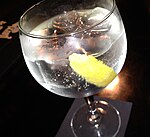
Mojito is a traditional Cuban punch. The cocktail often consists of five ingredients: white rum, sugar, lime juice, soda water, and mint. Its combination of sweetness, citrus, and herbaceous mint flavors is intended to complement the rum, and has made the mojito a popular summer drink.
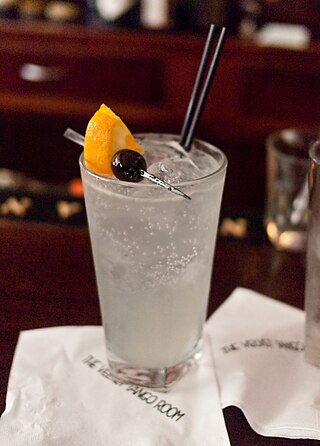
The Tom Collins is a Collins cocktail made from gin, lemon juice, sugar, and carbonated water. First memorialized in writing in 1876 by Jerry Thomas, "the father of American mixology", this "gin and sparkling lemonade" drink is typically served in a Collins glass over ice. A non-alcoholic "Collins mix" mixer is produced, enjoyed by some as a soft drink.
Pisco is a colorless or yellowish-to-amber colored spirit produced in winemaking regions of Peru and Chile. Made by distilling fermented grape juice into a high-proof spirit, it was developed by 16th-century Spanish settlers as an alternative to orujo, a pomace brandy that was being imported from Spain. It had the advantages of being produced from abundant domestically grown fruit and reducing the volume of alcoholic beverages transported to remote locations.

The sidecar is any cocktail traditionally made with cognac, orange liqueur, plus lemon juice. In its ingredients, the drink is perhaps most closely related to the older brandy crusta, which differs both in presentation and in proportions of its components.

The daiquiri is a cocktail whose main ingredients are rum, citrus juice, and sugar or other sweetener.
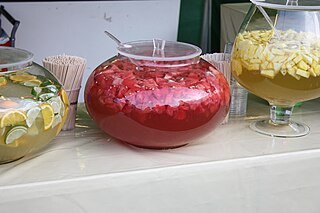
The term punch refers to a wide assortment of drinks, both non-alcoholic and alcoholic, generally containing fruits or fruit juice. The drink was introduced from the Indian subcontinent to England by employees of the East India Company in the late 17th century. Punch is usually served at parties in large, wide bowls, known as punch bowls.

A pisco sour is an alcoholic cocktail of Peruvian origin that is typical of Peruvian cuisine and Chilean cuisine. The drink's name comes from pisco, which is its base liquor, and the cocktail term sour, about sour citrus juice and sweetener components. The Peruvian pisco sour uses Peruvian pisco as the base liquor and adds freshly squeezed lemon juice, simple syrup, ice, egg white, and Angostura bitters. The Chilean version is similar, but uses Chilean pisco and Pica lime, and excludes the bitters and egg white. Other variants of the cocktail include those created with fruits like pineapple or plants such as coca leaves.

The tequila sunrise is a cocktail made of tequila, orange juice, and grenadine syrup. The drink is served unmixed in a tall glass. The modern drink originates from Sausalito, California, in the early 1970s after an earlier iteration created in the 1930s in Phoenix, Arizona. The cocktail is named for its appearance when served—with gradations of color resembling a sunrise.

The Fine Art of Mixing Drinks is a book about cocktails by David A. Embury, first published in 1948. The book is noteworthy for its witty, highly opinionated and conversational tone, as well as its categorization of cocktails into two main types: aromatic and sour; its categorization of ingredients into three categories: the base, modifying agents, and special flavorings and coloring agents; and its 1:2:8 ratio for sour type cocktails.

Cocktail garnishes are decorative ornaments that add character or style to a mixed drink, most notably to cocktails.
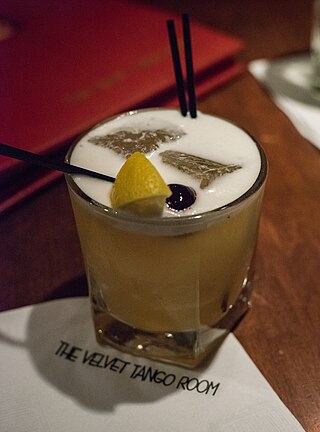
An amaretto sour is a cocktail using amaretto liqueur. It is a type of sour, a mixed drink made with a base spirit, citrus juice, and a sweetener. The drink is the most popular cocktail use for amaretto.
The brandy daisy is a cocktail which first gained popularity in the late 19th century. One of the earliest known recipes was published in 1876 in the second edition of Jerry Thomas's The Bartenders Guide or How To Mix Drinks: The Bon-Vivants Companion:
Fill glass one-third full of shaved ice. Shake well, strain into a large cocktail glass, and fill up with Seltzer water from a syphon.

A "fizz" is a mixed drink variation on the older sours family of cocktail. Its defining features are an acidic juice and carbonated water. It typically includes gin or rum as its alcoholic ingredient.
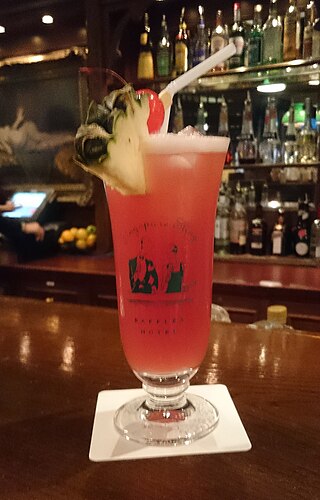
A sling is a drink historically made with sugar, hot or cold water, nutmeg, and a spirit such as gin, whiskey, rum, or brandy. In its modern form, it is made with gin and, varyingly, of ingredients such as sweet vermouth, lemon juice, simple syrup, Angostura bitters, and soda water. The word sling comes from the German schlingen, meaning "to swallow fast".

The vampiro is a cocktail that includes fruit juice, spices, fruit soda, fresh lime juice, and tequila. The vampiro has a fruity, lightly carbonated, and spicy taste.
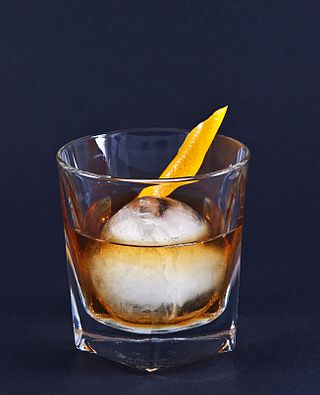
A whiskey cocktail is a cocktail that includes whiskey. Although whiskey is often served neat or on the rocks, it is used in many classic cocktails such as the Old Fashioned, Manhattan, and Julep. Some specifically call for Scotch whisky or bourbon whiskey.

The Airmail or Air Mail is a classic cocktail based on rum, lime or lemon juice, honey, and sparkling wine. It was probably created during or shortly after the period of prohibition in the United States of America or on Cuba, i.e. in the 1920s or 1930s.
















